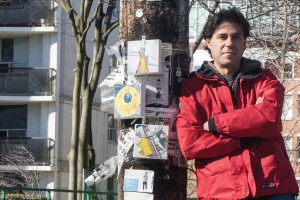Transforming neighbourhoods into open air galleries

Artist Jorge Molina poses on Walmer Road with some of his work. He is installing 416 canvases on utility poles throughout the city as part of his 416 Project.
NEILAND BRISSENDEN/GLEANER NEWS
By Annemarie Brissenden
The 416 Project, an ambitious city-wide guerrilla art installation, is set to hit the Annex in the coming weeks.
Canadian artist Jorge Molina is installing 416 six inch by six inch canvases on wooden utility poles in 35 neighbourhoods across Toronto. Each canvas depicts what Molina terms the “mundane stuff” seen around the poles.
“We love to regulate cultural production, but not all artworks work that way”—Derek Liddington, OCAD University
His works are proving so popular that he’s had to appeal to people to leave up the canvases for others to enjoy. The artist — also an actor who has appeared in Air Emergency, Rookie Blue, and Covert Affairs — had no idea his project would gain this much attention.
“I’m so blown away; it’s like people are craving this,” said Molina. “I just wanted to make people smile.”
His criteria for picking a neighbourhood is simple: it has to be in the 416 area code, and it needs to have wooden (not metal) poles, foot traffic, and a sidewalk. That’s all it takes to turn a neighbourhood into a gallery.
He is just the latest in series of guerrilla artists to take his work to the streets of Toronto.
“Street art is a growing recognized art form; we can’t grow the program fast enough”—Lilie Zendel, manager, START
Like Molina, all Matthew Del Degan wanted to do was “make people smile” when he began installing his army of LoveBots — grey hand-cast concrete sculptures — throughout the city six years ago.
Del Degan came up with the idea while he was sitting on the streetcar, observing that everyone around him was acting like robots, stuck on cellphones.
“We are all faceless robots…except we’re not robots; we all have big hearts.”
An OCAD University student at the time, he also had to design a toy project for a class, and all his ideas coalesced into one. Since then the movement has taken on a life of its own, and giant LoveBot murals featuring bright red hearts can be found adorning the sides of buildings throughout Toronto, while square stickers surprise letter writers when they post mail in some of Canada Post’s bright red street letter boxes. Del Degan even sells LoveBot stickers, apparel, and toys via his online shop.
Lilie Zendel isn’t surprised that such installations resonate with so many people. It adds to pedestrian enjoyment, enhances a neighbourhood’s uniqueness, and combats Toronto’s brutalist architecture.
She manages StreetARToronto (START), a City of Toronto program that combats graffiti vandalism by commissioning artists to create works of art on traffic signal boxes and paint murals in public spaces.
“Street art is a growing recognized art form; we can’t grow the program fast enough,” said Zendel. “We live in a city with such talent. You shouldn’t have to go into a gallery or institution to know that; you should see it at street level.”
She cautioned, though, that permission is what distinguishes graffiti vandalism and graffiti art. In addition to raising concerns about maintaining the work, she noted that, “if we are going to put up public or street art, then neighbours should have a voice.”
But for Del Degan, that’s exactly the point.
“You didn’t get a say about whether you want to look at a billboard,” he said. “I can put some art up, and make a difference.”
While he wants to add a little wonder to people’s lives and get them to be curious, he also wants to reclaim public space. “We have destroyed our public space; you can walk exclusively on sidewalks…[our whole way of life] is a construct.”
There’s a big difference between legal walls and non-legal walls, explained Derek Liddington, a sessional faculty member of OCAD University.
“Not all works fit into established rubrics. We love to regulate cultural production, but not all artworks work that way.”
He points to a wall tagged with Black Lives Matter, or Banksy’s works, as examples of art that are designed to push people to look outside their comfort zone, to challenge how people see. In his view, graffiti art and graffiti vandalism are inextricably linked: “if one supports one, one has to support the existence of the other.”
So far, Molina hasn’t had any push back from anyone about his city-wide installation.
“The canvases are on the same poles that people [use] for flyers,” he said. “I’m putting a piece of art on it.”
START is accepting applications for its Outside the Box program, in which local artists create works of art on traffic signal boxes throughout the city, until April 29 at 4.30 p.m. For further information, please contact streetart@toronto.ca.
READ MORE:
Untapped potential: Animating our local laneways (February 2016) by Joe Cressy
Incubating micro-retail: Laneways untapped realm of urban design (December 2015) by Annemarie Brissenden
Graffiti artist Erica Balon creates mural on Bloor Street West (July 2015) by Justine Ricketts
A new side to graffiti: SPUD counters war on graffiti with gallery exhibit (April 2012) by Jelena Subotic
